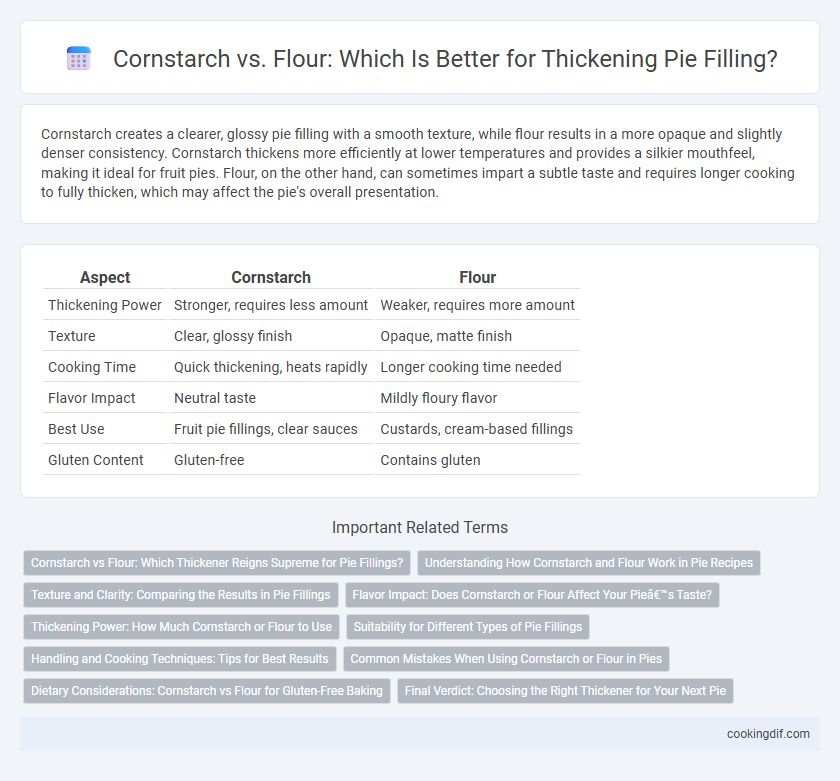Cornstarch creates a clearer, glossy pie filling with a smooth texture, while flour results in a more opaque and slightly denser consistency. Cornstarch thickens more efficiently at lower temperatures and provides a silkier mouthfeel, making it ideal for fruit pies. Flour, on the other hand, can sometimes impart a subtle taste and requires longer cooking to fully thicken, which may affect the pie's overall presentation.
Table of Comparison
| Aspect | Cornstarch | Flour |
|---|---|---|
| Thickening Power | Stronger, requires less amount | Weaker, requires more amount |
| Texture | Clear, glossy finish | Opaque, matte finish |
| Cooking Time | Quick thickening, heats rapidly | Longer cooking time needed |
| Flavor Impact | Neutral taste | Mildly floury flavor |
| Best Use | Fruit pie fillings, clear sauces | Custards, cream-based fillings |
| Gluten Content | Gluten-free | Contains gluten |
Cornstarch vs Flour: Which Thickener Reigns Supreme for Pie Fillings?
Cornstarch and flour are common thickeners for pie fillings, but cornstarch provides a clearer, glossier finish with a smoother texture, making it ideal for fruit pies. Flour, while less transparent and sometimes giving a slightly opaque look, offers a more robust thickening power and can hold up better during extended baking times. Choosing between cornstarch and flour depends on the desired filling consistency, clarity, and bake time for the perfect pie texture.
Understanding How Cornstarch and Flour Work in Pie Recipes
Cornstarch and flour both serve as thickening agents in pie fillings, but cornstarch creates a clearer, glossy finish and provides a smoother texture by absorbing liquid quickly and thickening at lower temperatures. Flour, containing gluten, yields a more opaque, matte look with a slightly pastier consistency, thickening as it cooks and often needing longer exposure to heat for maximum effect. Understanding the differences in thickening properties helps bakers choose the right ingredient based on desired filling clarity, texture, and cooking time.
Texture and Clarity: Comparing the Results in Pie Fillings
Cornstarch creates a glossy, translucent filling with a smooth, silky texture, ideal for fruit pies where clarity enhances visual appeal. Flour produces a more opaque, matte finish and a denser, slightly grainier texture, often resulting in a heavier pie filling. Choosing cornstarch over flour enhances the pie's presentation by providing a clearer, more refined consistency without sacrificing stability.
Flavor Impact: Does Cornstarch or Flour Affect Your Pie’s Taste?
Cornstarch creates a smoother, more translucent filling with a neutral flavor that lets the fruit's natural taste shine, while flour can produce a slightly opaque, denser texture with a mild, bready note that may subtly influence the overall flavor. Cornstarch tends to enhance the brightness of fruit fillings, making it ideal for pies where a clean, fresh taste is preferred. Flour's taste profile can add a homey, rustic element to the pie, which some bakers favor for deep, rich fillings.
Thickening Power: How Much Cornstarch or Flour to Use
Cornstarch has approximately twice the thickening power of flour, requiring about half the amount to achieve the same consistency in pie fillings. Typically, use one tablespoon of cornstarch for every two tablespoons of flour called for in a recipe to maintain optimal thickness without affecting flavor. This ratio ensures a clear, glossy filling when using cornstarch, whereas flour tends to produce a more opaque and slightly denser texture.
Suitability for Different Types of Pie Fillings
Cornstarch provides a clear, glossy finish ideal for fruit pie fillings like cherry or blueberry, enhancing their visual appeal and maintaining a tender texture. Flour works well for thicker, denser fillings such as pumpkin or sweet potato pies, offering a more opaque appearance and a robust set. Selecting the thickener depends on the pie's moisture content and desired consistency, with cornstarch favored for light, juicy fillings and flour suited to heavier, custard-based pies.
Handling and Cooking Techniques: Tips for Best Results
Cornstarch provides a glossy, translucent finish and thickens quickly at lower temperatures, making it ideal for fruit pie fillings that require minimal cooking time to preserve texture. Flour offers a more opaque, matte finish and requires longer cooking to eliminate its raw taste, so it works well in custard or savory fillings where gradual thickening and rich texture are desired. To achieve the best results, mix cornstarch with cold water before adding it to hot filling to prevent clumping, and cook flour-based fillings longer while stirring constantly to ensure smoothness and full thickening.
Common Mistakes When Using Cornstarch or Flour in Pies
Using too much cornstarch can cause the pie filling to become overly gelled and rubbery, while underusing it results in a runny texture. Flour often leaves a cloudy appearance and can develop a raw taste if not cooked long enough. Overheating either thickener may break down their thickening power, leading to a watery pie filling.
Dietary Considerations: Cornstarch vs Flour for Gluten-Free Baking
Cornstarch is a preferred thickening agent for gluten-free pie fillings because it contains no gluten, making it suitable for those with celiac disease or gluten sensitivity. Flour, commonly derived from wheat, contains gluten and is not safe for gluten-free baking, which can cause digestive issues in sensitive individuals. Cornstarch also provides a smoother texture and clearer appearance in pie fillings compared to flour, enhancing both dietary compatibility and aesthetic appeal.
Final Verdict: Choosing the Right Thickener for Your Next Pie
Cornstarch provides a clear, glossy finish and stronger thickening power at lower quantities, making it ideal for fruit pies that require a vibrant presentation and a stable, jelly-like consistency. Flour offers a more opaque, hearty texture with a subtle floury taste, better suited for rustic pies where a softer, creamier filling is preferred. For perfectly balanced pie fillings, select cornstarch when clarity and firmness are desired, while flour works best for richer, denser textures.
Cornstarch vs flour for thickening filling Infographic

 cookingdif.com
cookingdif.com